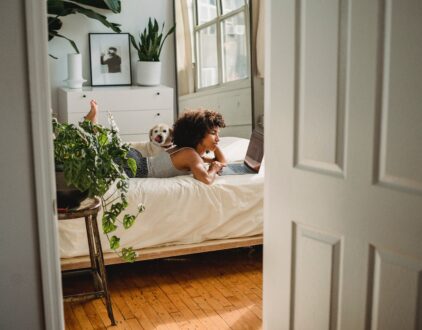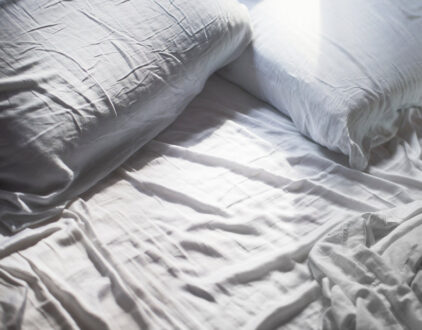Once “I” becomes “we” and sleepovers become a thing, getting a good night’s rest takes on a whole new meaning. Forget the relationship labels, the better question is do you wake up rested or desperate to hit the snooze button on your alarm? Cover hogs, snoring, and people that toss and turn like they’re fighting Mike Tyson in their sleep are all common complaints that boo’d up bed-sharers experience.
After filtering for bedding, finding the right room temperature and sleep environment, and of course, the right bed size so two people can sleep comfortably, a serious question many couples have is “What’s the best sleep position for us?” Weird sleep positions can cause you two to toss and turn all night, experience numb limbs, and just wake up frustrated.
Keep in mind that couples sleep positions are personal. Some people may love spooning while others might want to be back-to-back. This is one area where you need to worry less about body language interpretations and more about the most comfortable position for both of you to get proper recuperative sleep.
The Most Common Full Contact Couples Sleeping Positions
No matter whether you toss and turn or you wake up in the exact same position that you fell asleep in, these are some of the most common couples sleeping positions with full body contact. New couples that are still in the honeymoon phase of their relationship prefer these options.
Spooning
Spooning is often reserved for cuddling, but some couples like sleeping this way. As the name implies, one of you is the big spoon and the other is the little spoon. You’re back-to-chest in this position. Whoever’s the big spoon takes a protective position behind the little spoon usually with the mattress side leg or arm under their partner.
In the pros column, this position has lots of physical contact since your entire back or chest is touching your partner. However, the cons column is lengthy. The big spoon risks a numb arm or leg from extended time under the little spoon’s body. Likewise, the little spoon might get irritated by feeling their partner’s breath on the back of their head or neck. Additionally, both people can get overheated if they sleep hot. Don’t feel bad if you start in this position and a few minutes later shift into something a bit more comfortable.
Back-to-Back
Technically, this position can be a touch-free option. But if you still want some contact, you can scoot up to each other, back-to-back. Both of you are facing the edge of the bed, but still enjoying contact along your back or bums. If your style is bottom-only touching, this is known as the moon landing.
The upside here is that you still get contact, but both of you can breathe unobstructed. Likewise, no one’s risking numb limbs. But if you prefer facing each other, this position can feel alienating.
The Intertwined
The intertwined is another great option for couples that want to touch, but also face each other. This position is like an inverted spooning option. You both face each other, with each of you wrapping the mattress side arms under your partner. Usually one of you will wrap a leg on top of the other’s. Typically, one person’s head is cradled in the nook of the other’s neck.
This gives you plenty of face time with each other. Alternatively, you both risk numb arms. Meanwhile, people that sleep hot might get overheated after a while. Similar to spooning, don’t feel bad if you start in this position and shift to something a lot more breathable later on. If this position is too intense, you can try a variation called the cradle.
The Most Common Semi-Contact Couples Sleeping Positions
Once you’ve gotten comfortable with overnights at your partner’s house, or have moved in together, you might find that your sleep style changes. You might still want a little contact when you go to bed so that you’re close, but being a constant tangle of arms and legs might feel overrated now that you’re a legit couple.
The Chasing Spoon
A traditional spoon is a back-to-chest setup. This time, you two have some space between you so everyone breathes freely and the big spoon isn’t stuck with numb arms and legs. With this position, the big spoon uses their free arm to drape over the little spoon to maintain contact.
Another twist on the traditional spoon is the “loose spoon”. It’s pretty similar to the “chasing spoon” but lets you two shift back into the traditional spoon when the urge for more intense skin-to-skin contact arises.
Front-to-Front
This is a great twist on “the intertwined” position. Again, you both still have your arms draped on each other. But this time, there’s some space between you. This is great for maintaining contact — especially if you like being face-to-face. Alternatively, it’s not so great if one of you snores, or has horrific morning breath.
The Leg Hug
The leg hug is another great choice if you want a little bit of contact, but don’t want to feel like you’re suffocating from closeness. This position is exactly like it sounds, with just your legs connecting. It could be one partner crossed over the other, or both sets of legs completely tangled.
This position is great if you both have different sleep styles — i.e. one sleeps on their back and the other on their side or stomach — since you still get to be connected in a way that’s more natural. However, numb legs are still a risk.
The Most Common No-Touch Couple Sleeping Positions
Finally, couples might want these popular no-touch positions. You might start out in a more connected position and shift into this one after your partner falls asleep or you both get uncomfortable. Alternatively, some people prefer their space and will start this way. If you or your partner is an active sleeper, these options might be preferable.
Back-to-Back with No Contact
This is the same format as the full contact back-to-back except there’s space between you two. No contact back-to-back is ideal if you sleep hot, or if your mattress is too small. If your mattress feels pint-sized, there’s a good chance both of you are clutching the edges. If this sounds about right, consider upgrading to something more accommodating.
Front-to-Front with No Contact
If you prefer sleeping facing each other but want some space, this is a solid choice. Front-to-front no-contact is ideal if you like drifting off to sleep chatting about your day or gazing at your partner — but don’t want to be on top of each other. Just like the full contact front-to-front, you still risk full frontal snoring or bad breath.
Getting the Best Sleep from Couple Sleep Positions
Of all the position options, no-contact tends to be the most popular in the U.S. A 2017 study conducted by The Better Sleep Council found that of respondents, 63% prefer to sleep with space between them. Meanwhile, women in heterosexual relationships from that same study reported getting worse sleep than their male partners. 44% and 42% of women who completed the survey shared that the biggest culprits were active sleepers and snoring respectively. So, if good sleep is eluding you now that you’re half of a couple, consider these tips.
Along with cutting out screen time before bed, and creating a comfortable environment that promotes sleep, Carlie Gasia, a Spencer Institute-endorsed Certified Sleep Science Coach at Sleepopolis reminds people not to be afraid to “discuss sleep concerns with your partner and work together to find solutions.”
Other sleep aids like white noise machines, dual-zone bedding, or even earplugs are all traditional tools that might help you combat your partner’s unintentional wood sawing. Additionally, don’t discount the importance of good bedding and a mattress that’s compatible with your sleeping style (back, side, or stomach). If you both prefer wildly different sleep styles and firmness levels, a dual-zone mattress is a smart investment.
Similarly, a mattress with temperature control support, or adding in weighted blankets can all help couples with very different sleep profiles fall asleep comfortably while sleeping together. Jill Zwarensteyn, a Certified Sleep Science Coach of Sleep Advisor recommends the Scandinavian sleep method. This includes couples sharing a bed but using different covers. This is ideal if you prefer different sleep temperatures or a weighted blanket while your partner doesn’t.
Get Restorative Sleep in Couple Sleeping Positions
Whether you’re completely draped on your partner, or sleep unobstructed with your back to them, there’s a sleep position that’s meant for you. Keep in mind that you can always start in one position and then shift into something more comfortable as the night progresses. But if snoring, tossing and turning, or other nighttime distractions are keeping you from getting your 40 winks, don’t be afraid to speak up.
popular posts
- 1It’s Black Business Month, So Let’s Go Shopping and #BuyBlack!
- 2These Home Decor Items Will Instantly Make Your Space Look Outdated
- 3Black-Owned Home Decor Stores To Support Across the United States
- 4A Look Inside Elon Musk's Tiny $50,000 House
- 57 Black and Multicultural Designers To Follow For Design Inspo
Bedroom
Spaces
Whether it’s luxury or ease, every area of your home should be as fabulous and unique as you.

Ready for a Bedroom Makeover? Check Out These 8 Fabulous Buys
by Arielle Clay | January 19, 2023
FOLLOW ALONG ON INSTAGRAM
#homeandtexture
Find us on social for more home inspiration where culture, personal style, and sophisticated shopping intersect to help you create a home where you love to live.







